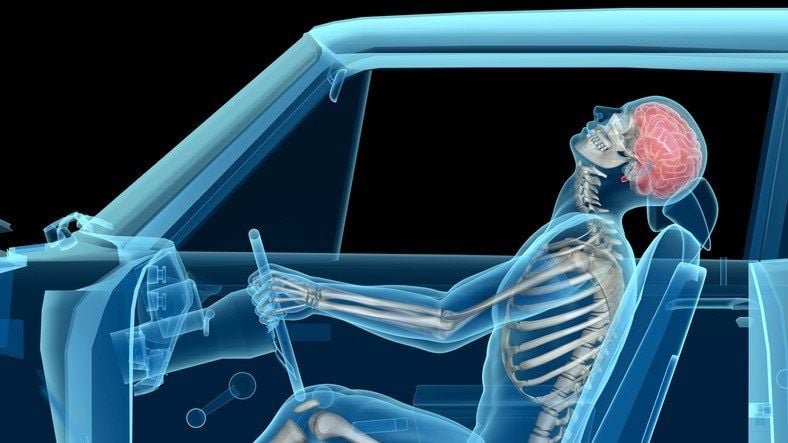What Is Whiplash?

The more you know about whiplash, the more likely you are to recover. The more you ignore whiplash, the more serious the condition becomes.
Whiplash is a soft tissue injury that occurs to a person's neck following a sudden accident that includes an unexpected acceleration-deceleration force, causing a rapid forward and backward movement in the head and neck.
Whiplash is most common among car accidents.
It describes damage to both soft tissues and bone structures. But when it comes to whiplash-associated disorders, these are more severe conditions to consider.
Although a whiplash injury is not life-threatening, it still needs proper care and medication.
It can lead to a prolonged period of partial disability when not cured immediately.
Causes of Whiplash
Things like a car accident typically cause whiplash, as well as:
- Assault
- Riding a rollercoaster
- Horseback riding
- Joining a sports activity
- Cycling accidents
- Significant blows to the head
- Falls where the head violently jolts backward
Even the most minor accidents may still cause whiplash.
Individuals Who Are More Prone to Whiplash
There are certain people more prone to whiplash injuries:

- Women
- Younger individuals
- Neck pain history
- A job with monotonous work
- People in rear-end collisions
- People hit while their car is stopped
Stages of Whiplash Injury
First Phase - The first stage of whiplash injuries happens when the vehicle is pushed out from under the person.
This causes the mid-back to flatten against the seat's back, and the cervical spine is pushed upward, which squeezes both the discs and joints. When the seat accelerates forward, the head moves backward, thus, producing a force on the neck.
Second Phase - For this stage of a whiplash injury, the torso has reached peak acceleration, but the head has not yet accelerated forward.
This is where an S-curve advances in the cervical spine right when the back of the seat recoils forward, which adds to the torso's forward acceleration.
This usually happens when the head is moving backward, which results in the neck's sharp force that is already causing neck injury.

Third Phase - This part is where the torso descends back to the seat while both the head and neck are already at their peak forward acceleration. This is when your vehicle starts to slow down.
When the person applies the brake to slow down, the severity of the neck's injury happens. This occurs when the person moves forward, but the seat belt is already taken up.
Fourth Phase - This is the most destructive phase of a whiplash injury.
This happens when the torso is stopped by the seatbelt, where the shoulder is restrained aside from your head, which is free to move forward.
This is observed in the neck's violent forward-bending action, which strains both the ligaments and muscles, thus, tearing the spinal discs' fibers.
It also forces the vertebrae out from its normal position while your nerve roots and the spinal cord get stretched too much and become irritated.
This also brings the brain to strike right inside the skull, which causes brain injury.
For additional information, check out the four phases of whiplash.
What Symptoms After a Car Accident Should I Not Ignore?
Don't ignore neck pain right after a car accident.
Symptoms usually last around 24 hours after the accident, but some victims have found symptoms after a few days or weeks.
Symptoms you are likely to experience are:
- Dizziness
- Weariness
- Neck pain
- Blurred vision
- Stiffness of the neck
- Headaches at the base of the skull.
Less common symptoms of the whiplash include:
- Irritability
- Ringing in the ears
- Inability to experience a restful sleep
- Chronic pain in the neck, head, and shoulders
- Difficulty with memory and concentration
Results of Whiplash
Headache![severe headache after whiplash injury severe headache after whiplash injury]()
Headache - Considered the most predominant complaint after a motor vehicle accident. Headaches affect 80% of car accident victims.
Dizziness - Dizziness may result from the facet joints injury. It can also affect the brain stem. While dizziness usually is temporary, victims are still required to see a medical specialist such as a chiropractor.
Neck Pain - Around 90% of patients have reported neck pain due to car collisions. The pain radiates, starting across the shoulders, to the head, and right down between the blades of the shoulders.
The trauma significantly affects the neck's tissues, such as discs and facet joints, as well as the nerves, ligaments, and muscles.
Brain Injury - This can occur because of the forces on the brain during the accident.
When the brain is pushed forcedly forward, and backward inside the skull is what leads to bruising and even in the brain's bleeding.
This is where some patients lose consciousness and obtain mild concussion.
When not treated right away, long-term problems of the brain may occur. Things like forgetfulness, irritability, sleep disturbances, mild confusion, difficulty concentrating, emotional instability, and loss of sex drive can occur.
Jaw Problems - Temporomandibular Joint (TMJ) Dysfunction is less common.
The victim may experience popping noises in the jaw when moving.
When not treated, the disorder may worsen, which could lead to headaches, ear pain, facial pain, and eating problems.
Low Back Pain - Even if whiplash happens on the neck, it also injures the person's low back.
This occurs because the low back may experience tremendous compression during the accident.
Death
Death - A whiplash accident causes bruising to the brain.
Professionals find it hard to see the damage beyond the microscopic level, even using CT or MRI scans.
When ignored, whiplash may cause a long-term problem and even death, though unlikely.
Get a Proper Diagnosis Before Beginning Treatment
Patient's History Collection
The doctor will ask the patient's complete medical background, such as family history, possible pre-existing conditions, and other health considerations before working with the physical exam and diagnostic imaging.
Physical Examination
The medical professional will touch and move your neck, head, and arms. They will also ask you to perform simple tasks to help him find out about:
- The tenderness of your neck, shoulders, and back.
- Your neck's and shoulders' range of motion.
- Your limbs' strength, reflexes, and sensation.
- The degree of motion which increases the pain.
For the usual start of the test, this brings in:
- Observation: Both neck and posture of the patient are thoroughly examined for any possible abnormalities and misalignment.
- Palpitation: The doctor will feel any tightness and tenderness in various sections of the neck.
- Motion range: The physician tests neck mobility. This works by the rotation, up and down, and side by side movements of the neck.
A doctor may investigate further when an irritated nerve follows. This can include:
- Reflexes: This is where the professional may use a rubber hammer to see if the nerves on the neck send out the right signals for the forearm, biceps, and triceps.
- Sensation: Sensation aids in narrowing which cervical spine segment is the possible source of the problem.
- Muscle power: This is a basic test to see if the shoulders, arms, and hands display any likely weakness.
Imaging Tests

Imaging tests are vital to help the doctor identify the cause of the pain.
- X-rays: X-rays taken at various angles can help identify possible fractures, arthritis, and dislocations.
- Bone Scan: This procedure is beneficial to help the doctor detect any tiny fractures in the bone.
- Computerized Tomography Scan: This helps in creating various cross-sectional images of the patient's bones. It even assists in revealing particular details when it comes to the damage.
- Magnetic Resonance Imaging: This is a unique technology that uses radio waves and magnetic fields to create 3-D images in exquisite detail. Aside from that, this measure aids in seeing any injuries from the soft tissue.
Helping Out With the Recovery
Self-care
This can be applied when your whiplash symptoms are ranged from mild to moderate.
- By resting: Rest is vital for whiplash injury patients, although they need to be active. But when the patient worsens the pain because of an activity, they are advised to limit or avoid the movement to make up time for healing.
- Use an ice pack: This helps reduce pain and swelling after the injury by doing it around 15 minutes. Patients need to apply the towel-wrapped ice pack every 3-4 hours for approximately 2-3 days.
- Use a brace: A brace is useful in adding support to the injury. The doctor usually recommends this because neck braces, when used long-term, may weaken your muscles.
- Apply moist heat on the injury: Applying heat on the neck is good, but only after 2-3 days of applying ice on it.
Medical Care
This is for severe whiplash symptoms. If the indications seem to be not going away, then you have to consider medical treatment, such as:
- Injections: Injections help treat joint relief, irritated muscle relief, and nerve and tissue inflammation reduction.
- Acupuncture: Acupuncture is a practice where needles are placed in various areas of the body, which requires healing. This procedure can help in the relief of pain right after whiplash trauma. It is essential to see a licensed acupuncturist here to get safe and effective treatment.
- Psychotherapy: After a whiplash injury, some victims may suffer from psychological conditions like depression and post-traumatic stress disorder. With this, a mental health doctor must offer counseling that best suits the patient's needs.
- Physical therapy: This is applied by a well-trained and well-experienced physical therapist. It can also be worked with a qualified health professional that can help in your neck's strength and flexibility.
- Massage therapy: A massage therapy for whiplash trauma is a brilliant combination of chiropractic care and physical therapy. It helps in reducing muscle pain and raises blood flow.
- Chiropractic care: Chiropractic care is one of the best ways to help relieve symptoms of whiplash. It is done with manual adjustments focusing on the spine to increase its range of motion, aside from dropping the felt pain. Your chiropractor will choose the best adjustment for you. This article explains more about selecting the right adjustment.
- Radiofrequency neurotomy: This procedure works by targeting specific nerves with heat. It helps in creating a lesion to prevent face joints from sending signals right to the brain.
- Pain medication prescriptions: Over-The-Counter drugs can be used in treating the discomfort, and a doctor can advise you on proper medication. The most common ones given by these specialists are opioids and muscle relaxants.

Before Seeing a Doctor
It is essential to be wholly prepared in seeing your doctor when experiencing something different or painful in your neck, head, and shoulders.
Check out these considerations to help guide you through the intensity of the pain.
- Start by rating your pain
- Know if any movement will worsen the pain
- Check out symptoms you are experiencing after the accident
- Know the length of these symptoms
- See those medications you regularly take, such as herbal medicines and dietary supplements.
Recovery Time for Patients
By just three months, patients may commonly recover from the trauma. However, it is also possible for some patients to find the problem chronic.
Risk factors which help in the indication of a patient's recovery time from the damage:
- Women: Women have smaller muscles and structures, so they are more susceptible to this injury.
- Older folks: Older individuals may face more degeneration in the spine. Also, they may experience pre-existing conditions in the spine, which makes them vulnerable to the injury.
- Severe pain: Severe pain right after the impact is an excellent indication that more alarming damage has occurred. This brings in longer recovery time for the patient.
- Post-traumatic stress disorder: People who keep thinking about the accident may end up just avoiding driving altogether. Restlessness and depression may also set in.
Although progress has been made with the patient's longer recovery times, clinical tests are still done to help with the estimation of the injury's severity.
How to Prevent Whiplash Trauma
There are things you should understand to help prevent a whiplash accident. These include:
- Personal responsibility when driving - You shouldn't speed. They should avoid alcohol and drugs when driving.
- Prevention of sports injuries and falls among the elderly.
- Performing exercises that can strengthen neck muscles.
- Laser-initiated braking systems to avoid collisions. Seat design also matters.
- Using the recommended safety equipment at work, home, and even sports activities.
- Car owners should use headrests that are correctly fitted.
Where Do We Go From Here?

Untreated whiplash can cause severe problems, so patients need to see a doctor that can provide proper treatment.
If you live in the greater Atlanta area and have experienced whiplash from a car accident, do not risk long-term injury.
Contact our quality and professional chiropractors for a free consultation to get you back to full health.
The Arrowhead Clinic can also refer you to a personal injury lawyer during your free consultation.





.jpg)